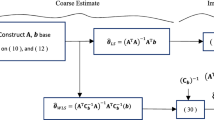Abstract
Ranging error is known to degrade significantly the target node localization accuracy. This paper investigates the use of computationally efficient positioning solution of least square (LS) in closed-form, to reduce localization accuracy loss caused by ranging error. For range-based node localization, the LS solution based on least square criterion has been confirmed to exhibit capability of optimum estimation but extensively achieve at a very complex calculation. In this paper we consider the problem how to acquire such LS solution provided with estimation performance at low complex calculation. In this paper, we use the Gauss noise model and use the weighted least squares criterion and the effective calculation method to solve the linearized equation derived from the RSS measurement, and put forward a new approach to estimate the performance of the target node location estimation. Based on the Fisher information matrix, the Cramér–Rao lower bound of target position estimation is derived based on received signal strength. We obviously indicate that the proposed algorithm can approximately achieve the LS solution in estimation performance at a markedly low complex calculation. Simulations are performed to show the improvement of the proposed algorithm.




Similar content being viewed by others
References
Li S, Wang Z, Li Y (2013) Using laplacian eigenmap as heuristic information to solve nonlinear constraints defined on a graph and its application in distributed range-free localization of wireless sensor networks. Neural Process Lett 37(3):411–424
Decarli N, Guidi F, Dardari D (2014) A novel joint RFID and radar sensor network for passive localization: design and performance bounds. IEEE J Sel Top Signal Process 8(1):80–95
Li S, Qin F (2013) A dynamic neural network approach for solving nonlinear inequalities defined on a graph and its application to distributed, routing-free, range-free localization of WSNs. Neurocomputing 117(117):72–80
Wang T, Shen Y, Mazuelas S, Shin H, Win MZ (2014) On OFDM ranging accuracy in multipath channels. IEEE Syst J 8(1):104–114
Li S, Lou Y, Liu B (2014) Bluetooth aided mobile phone localization: a nonlinear neural circuit approach. ACM Trans Embed Comput Syst 13(4):1–15
Gu J, Chen S, Sun T (2011) Localization with incompletely paired data in complex wireless sensor network. IEEE Trans Wirel Commun 10(9):2841–2849
Li S, Liu B, Chen B, Lou Y (2013) Neural network based mobile phone localization using bluetooth connectivity. Neural Comput Appl 23(3):667–675
Chan YT, Ho KC (1994) A simple and efficient estimator for hyperbolic location. IEEE Trans Signal Process 42(8):1905–1915
Wang G, Yang K (2011) A new approach to sensor node localization using RSS measurements in wireless sensor networks. IEEE Trans Wirel Commun 10(5):1389–1395
Patwari N, Hero AO III, Perkins M, Correal NS, O’Dea RJ (2003) Relative location estimation in wireless sensor networks. IEEE Trans Signal Process 51(8):2137–2148
Zekavat R, Buehrer RM (2011) Handbook of position location: theory, practice and advances. Wiley, New York
Gavrilovska, L, Atanasovski V, Rakovic V, Denkovski D, Angjelicinoski M (2013) REM-enabled transmitter localization for ad hocscenarios. In: Proceedings of IEEE military communications conference (MILCOM), San Diego, CA, USA, pp 731–736
Savvides A, Han C-C, Strivastava MB (2001) Dynamic fine-grained localization in ad-hoc networks of sensors. In: Proceedings of the 7th annual international conference on mobile computing and networking. pp 166–179
Chen H, Ping D, Xu Y, Li X (2006) A novel localization scheme based on RSS data for wireless sensor networks. In: Shen HT (ed) Advanced web and network technologies, and applications. Springer, New York, pp 315–320
Patwari N, Ash JN, Kyperountas S, HeroIII AO, Moses RL, Correal NS (2005) Locating the nodes: cooperative localization in wireless sensor networks. IEEE Signal Process Mag 22(4):54–69
Salman N, Ghogho M, Kemp AH (2014) Optimized low complexity sensor node positioning in wireless sensor networks. IEEE Sens J 14(1):39–46
Lin L, So HC, Chan YT (2014) Received signal strength based positioning for multiple nodes in wireless sensor networks. Digit Signal Process 25(25):41–50
Sichitiu ML, Ramadurai V (2004) Localization of wireless sensor networks with a mobile beacon. In: Proceedings of the IEEE international conference on mobile ad-hoc and sensor systems. pp 174–183
Kay SM (1993) Fundamentals of statistical signal processing: estimation theory. Prentice-Hall, Englewood Cliffs
Patwari N, Hero A III, Perkins M, Correal N, O’Dea R (2003) Relative location estimation in wireless sensor networks. IEEE Trans Signal Process 51:2137–2148
Acknowledgements
The authors would like to thank all of the discussion and suggestions for the help of this paper. This research was supported by The National Natural Science Foundation of China (Grant No. 21276111).
Author information
Authors and Affiliations
Corresponding author
Rights and permissions
About this article
Cite this article
Zhang, X., Xiong, W. & Xu, B. A Computationally Efficient Received Signal Strength Based Localization Algorithm in Closed-Form for Wireless Sensor Network. Neural Process Lett 46, 1043–1057 (2017). https://doi.org/10.1007/s11063-017-9625-3
Published:
Issue Date:
DOI: https://doi.org/10.1007/s11063-017-9625-3




